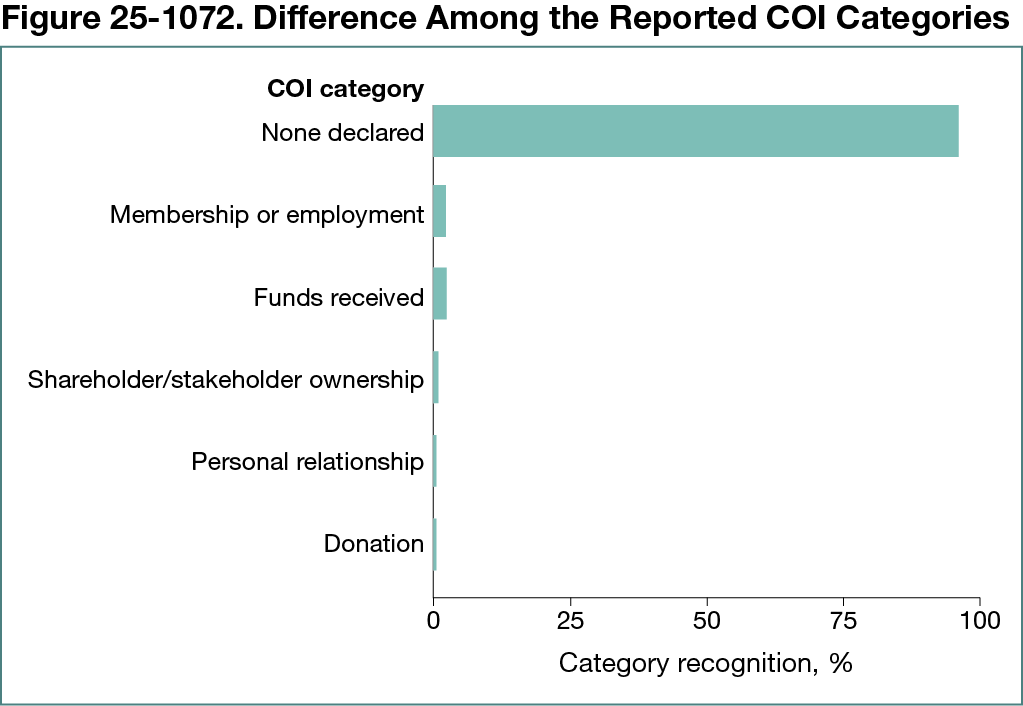Abstract
A Taxonomy-Based Guideline Framework for Conflict of Interest Disclosures (CoST)
Pritha Sarkar,1 Ruth Whittam,1 Leslie D. McIntosh1
Objective
Properly declaring conflicts of interest (COIs) is essential for assessing potential bias in scholarly publications and maintaining research integrity. However, COI declarations are often inconsistent with significant variation in the requirements set by different journals. This leads to discrepancies in reporting and contributes to confusion regarding what constitutes a complete and transparent COI disclosure. This study uses a data-driven approach to create and measure a COI declaration taxonomy akin to CReDiT.1 If journals standardize COI reporting requirements to this taxonomy, it will help address these inconsistencies.
Design
In 2023, Dimension’s full-text database2 was used to perform a descriptive study on COI statements found in 2966 randomly selected open-source research papers published between 2012 and 2023. COI declarations were classified in 6 primary categories: (1) none declared, (2) membership or employment, (3) stakeholder or shareholder ownership, (4) funds received, (5) personal relationship, and (6) donation. Using natural language processing tools, ~10% (297) of the statements from the initial pool of 2966 statements were manually annotated, creating a standard for automatic annotation of COI statements. Later, our analysis also leveraged the Retraction Watch3 database to assess COI-related retractions when it became public in September 2023.
Results
Our model, which identifies both undeclared COIs and its categories, found that only 896,893 of 16,044,369 gathered COI statements mentioned at least 1 COI category. The skewness among the recognized COI categories is depicted in Figure 25-1072. The data also revealed significant inconsistencies in COI disclosures (eg, variations in the structure and clarity of statements). Moreover, when the Retraction Watch database3 was compared with the database for Dimensions,2 it was observed that among 24,289 overlapping papers, 393 were retracted because of COIs. Of those 393 papers, 349 (~89%) had initially declared no COI.
Conclusions
Due to the varying requirements imposed by different journals, authors often face confusion in clearly and concisely declaring COIs. As a result, many resort to minimal statements such as ”none declared,” and, in some instances, ambiguous terms such as “nil” or “none.” This undermines the intent of transparency. The study highlights this critical gap in the standardization and understanding of COI declarations, emphasizing the need for a structured framework to enhance clarity and transparency. To bridge this gap, we propose Conflict of interestS Taxonomy (CoST), a guideline for COI reporting. This framework provides authors with a straightforward, questionnaire-style tool to ensure consistency and completeness in COI declarations. By fostering adherence to journal and institutional standards, this taxonomy may promote trust within the research community and strengthen the credibility of scientific publications. Our work highlights the importance of systemic change in COI reporting to safeguard the integrity of scholarly communication.
References
1. Contributor Role Taxonomy. Contributor Role Taxonomy (CRediT). 2022. https://credit.niso.org/
2. Hook DW, Porter SJ and Herzog C. Dimensions: Building Context for Search and Evaluation. Front Res Metr Anal. 2018;3:23. doi:10.3389/frma.2018.00023
3. The Retraction Watch Database. Retraction Watch Version 1.0.8.0. http://retractiondatabase.org/
1Digital Science, London, UK, p.sarkar@digital-science.com.
Conflict of Interest Disclosures
All authors are employees of Digital Science. None of the authors received any donation or funds for the study.

